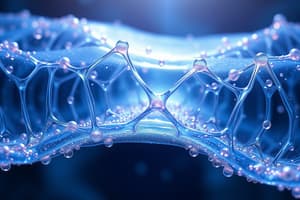Podcast
Questions and Answers
What is the primary role of cell (plasma) membranes?
What is the primary role of cell (plasma) membranes?
To enclose the contents of the cell, separating intracellular components from the extracellular environment, allowing for the precise control of internal conditions (homeostasis).
What are the two key properties of cell membranes that promote homeostatic regulation?
What are the two key properties of cell membranes that promote homeostatic regulation?
They are semi-permeable and selective.
Each phospholipid consists of a polar phosphate head and two non-polar _____ _____ tails.
Each phospholipid consists of a polar phosphate head and two non-polar _____ _____ tails.
fatty acid
The phosphate head of a phospholipid is hydrophobic.
The phosphate head of a phospholipid is hydrophobic.
What does it mean for a molecule to be amphipathic?
What does it mean for a molecule to be amphipathic?
How do phospholipids spontaneously arrange themselves in an aqueous environment?
How do phospholipids spontaneously arrange themselves in an aqueous environment?
What type of associations hold the phospholipid bilayer together?
What type of associations hold the phospholipid bilayer together?
Which type of membrane protein spans the entire bilayer and is permanently attached?
Which type of membrane protein spans the entire bilayer and is permanently attached?
Which type of membrane protein associates with only one side of the membrane and is temporarily attached?
Which type of membrane protein associates with only one side of the membrane and is temporarily attached?
How can peripheral proteins typically be dissociated from the cell membrane?
How can peripheral proteins typically be dissociated from the cell membrane?
Match the membrane protein function (JET RAT) to its description:
Match the membrane protein function (JET RAT) to its description:
What is glycosylation?
What is glycosylation?
Glycosylation of membrane proteins produces _____.
Glycosylation of membrane proteins produces _____.
Glycosylation of phospholipids results in _____.
Glycosylation of phospholipids results in _____.
On which side of the cell membrane are the carbohydrate chains of glycoproteins and glycolipids typically located?
On which side of the cell membrane are the carbohydrate chains of glycoproteins and glycolipids typically located?
ABO blood group antigens are examples of glycoproteins.
ABO blood group antigens are examples of glycoproteins.
What are the two key qualities of the plasma membrane described by the fluid-mosaic model?
What are the two key qualities of the plasma membrane described by the fluid-mosaic model?
In the fluid-mosaic model, what does the term 'fluid' signify?
In the fluid-mosaic model, what does the term 'fluid' signify?
In the fluid-mosaic model, what does the term 'mosaic' signify?
In the fluid-mosaic model, what does the term 'mosaic' signify?
Who proposed the fluid-mosaic model of membrane structure?
Who proposed the fluid-mosaic model of membrane structure?
Flashcards
Cell membrane function
Cell membrane function
Membranes enclose cell contents, separating intracellular from extracellular environments, allowing precise control of internal conditions.
Semi-permeable membrane
Semi-permeable membrane
A membrane that allows some materials to cross without help, while others cannot.
Selective membrane
Selective membrane
A membrane that regulates the passage of certain materials according to need.
Phospholipid
Phospholipid
Signup and view all the flashcards
Amphipathic
Amphipathic
Signup and view all the flashcards
Phospholipid Bilayer
Phospholipid Bilayer
Signup and view all the flashcards
Integral proteins
Integral proteins
Signup and view all the flashcards
Peripheral proteins
Peripheral proteins
Signup and view all the flashcards
Junction proteins
Junction proteins
Signup and view all the flashcards
Enzyme proteins
Enzyme proteins
Signup and view all the flashcards
Transport proteins
Transport proteins
Signup and view all the flashcards
Recognition proteins
Recognition proteins
Signup and view all the flashcards
Adhesion proteins
Adhesion proteins
Signup and view all the flashcards
Transduction proteins
Transduction proteins
Signup and view all the flashcards
Glycosylation
Glycosylation
Signup and view all the flashcards
Glycolipids
Glycolipids
Signup and view all the flashcards
Glycoproteins
Glycoproteins
Signup and view all the flashcards
Amorphous Membranes
Amorphous Membranes
Signup and view all the flashcards
Fluid-mosaic model
Fluid-mosaic model
Signup and view all the flashcards
Study Notes
- Cell membranes enclose the cell's contents, separating intracellular components from the extracellular environment
- Precise control of internal conditions (homeostasis) is enabled by this separation
- Two key properties of cell membranes promote homeostatic regulation
Selective Permeability
- Cell membranes are semi-permeable, meaning some materials cannot cross the membrane without assistance
- Cell membranes are selective, meaning they can regulate the passage of materials
Phospholipid Bilayer Composition
- Membranes consist of a phospholipid bilayer
- Each phospholipid has a polar phosphate head and two non-polar fatty acid tails
- Phosphate heads are hydrophilic (water-loving)
- Fatty acid tails are hydrophobic (water-hating)
- Phospholipids are amphipathic, meaning they are both hydrophilic and hydrophobic
Bilayer Formation and Structure
- Phospholipids spontaneously arrange into a bilayer
- Hydrophilic phosphate heads face outwards towards aqueous solutions (cytosolic and extracellular fluids)
- Hydrophobic fatty acid tails face inwards to avoid exposure to polar fluids
- Bilayer is held together by weak hydrophobic associations between fatty acid tails
- This arrangement allows for membrane fluidity and flexibility
Membrane Proteins
- Phospholipid bilayers are embedded with proteins that can be permanently or temporarily attached
Integral Proteins
- Transmembrane proteins that span the bilayer and are permanently attached to the membrane
- Cannot be easily dissociated without disrupting the bilayer (e.g., using detergents)
- Examples include ion channels, carrier proteins, and protein pumps
Peripheral Proteins
- Associate with one side of the membrane and are temporarily attached to the bilayer
- Can easily be dissociated using a polar solvent
- Examples include receptor complexes associated with signal transduction pathways (e.g., G proteins)
Functions of Membrane Proteins
- Serve a variety of key functions
Junctions
- Connect cells together to form tissues (tight junctions)
Enzymes
- Immobilize enzymes on membranes to localize specific reactions
Transport
- Facilitate the passage of materials across the bilayer (channel proteins)
Recognition
- Act as markers for cell identification (e.g., antigens)
Adhesion
- Serve as attachment points for the cytoskeleton or extracellular matrix
Transduction
- Act as receptors for signaling pathways (glycoproteins)
Glycosylation
- Phospholipids and membrane proteins can have carbohydrate chains attached via glycosylation
- Glycosylation of phospholipids produces glycolipids
- Glycosylation of membrane proteins produces glycoproteins
- Carbohydrate chains are on the extracellular side of the membrane, playing roles in cell adhesion and recognition
Cell Adhesion
- Surface carbohydrates (glycoproteins) can serve as attachment points for cells (e.g., sperm binding sites)
Cell Recognition
- Surface carbohydrates can act as recognition points between cells (ABO antigens are glycolipids)
- Glycoproteins and glycolipids help maintain the structural integrity of the extracellular matrix
- Carbohydrate chains can link extracellular molecules, helping create a cohesive network
Fluid-Mosaic Model
- Describes two key qualities of the plasma membrane
Fluidity
- Phospholipids can move position, making membranes amorphous (able to change size or shape)
Mosaicism
- The bilayer is embedded with proteins and carbohydrates, creating a mosaic of components
- This model was proposed by Singer and Nicolson in 1972 and is currently accepted
Studying That Suits You
Use AI to generate personalized quizzes and flashcards to suit your learning preferences.




